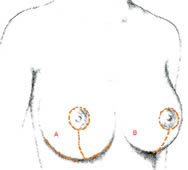Breast Reduction (reduction mammaplasty)
Women who wish to have a breast reduction are those who have physical problems such as neck ache, pain in the shoulders and in the back due to overly large breasts. Mamma hyperplasia (overly large breasts) can cause chronic headaches, backache, and neck ache. It can also cause sulcus in the area of the shoulders and cutaneous irritations. A mamma reduction involves removing the excess breast tissue, and then reshaping and lifting the breast in order to adjust it to the proportion of your body.
Payment of the Costs/Covering the Costs
Operation costs may be covered by a medical insurance if you suffer from any of the health problems cited above. In Switzerland, the major medical insurances will cover costs but there is a minimum weight requirement of 500g / 17.63 oz of breast fat to be removed and the patient’s BMI (Body Mass Index) should not exceed 25kg/m2.
What is a Breast Reduction?
The aim of a breast reduction is to reduce the size and weight of the breasts in order to improve your lifestyle in a more active way. After the operation, most women experience a lessening of chronic back, neck and shoulder pains. Reduction mammaplasty is undertaken for functional purposes. A breast lift can be performed at the same time, but is only for aesthetic purposes.
Personal Consultation
Depending on the pains you are experiencing, the different choices for breast reduction are explained to you during a personal consultation. The operation, the risks and limitations are explained in detail. You will also be told about the different anaesthetics.
Then, a photograph of the breasts will be taken for documentation purposes. A mammogram might also be required.
Techniques

Usually, a breast reduction is performed using “keyhole” surgery. The surgeon incises where the nipple meets the breast and then continues down in a line to the fold of the breast. The skin, the glandular tissue and the fat are removed and then the nipple is replaced in its new position. Next, the skin under the areola is lifted on both sides of the breast in order to give the breast its new shape. In the end, the scar will either be a reversed-T, or a vertical line. Sometimes, it is possible to perform the operation without making an incision in the fold of the breast. This type of vertical mammaplasty depends on the size of the breasts and the amount of tissue that needs removing. During the operation the nipples remain connected to their blood vessels. However, in the case of very large, heavy, hanging breasts the nipples may temporarily removed in order to implant them further up. Consequently, a more marked insensitivity of the nipples will follow and a complete inability to breastfeed.
Sometimes, liposuction will be required during a breast reduction.
Length of a Breast Reduction
A breast reduction takes three to four hours. The length of the operation depends on the volume of tissue that has to be removed and the operation technique used.
Is it an outpatient operation?
Most breast reductions can be performed in an outpatient setting. The patient can leave the one-day clinic after a couple of hours, but it is essential that they are accompanied. The patient will remain under medical surveillance if the amount of tissue removed was large.
This intervention is always performed under general anaesthetic. .
Pain
Even after a major breast reduction, pain after surgery is relatively minor and can be controlled with analgesics. After the operation, it may be uncomfortable to leave bed or to walk. The movement of the breasts due to walking can feel painful, but his will improve after a few days.
Following the operation
The breasts are dressed with an adhesive bandage, which will be changed a week after surgery. The dressing must remain in place for six to eight weeks, to achieve optimal healing. A special bra is worn for several weeks until the inflammation has lessened and the breasts heal internally. Draining of the wound may be necessary in order to remove residual liquid.
The patient must be accompanied for their journey home. Driving a car is prohibited. It is advisable to have help at home for the first days following surgery.
After the operation
The special adhesive bandage will be changed after one week. It must be worn for six weeks in order to achive optimal healing of the scars. The patient will have to wear a special bra for several weeks, until the inflammation subsides and scar healing has finished.
Light activity can be undertaken after only a few days. However, you must avoid doing sport for at least six weeks. This encourages the healing process. Some women complain about the sudden appearance of pain in the nipples and on the side of the breasts, which means that the nerve endings are growing and that sensitivity is returning.
Usually, breast-feeding remains possible after most surgery, but it is not guaranteed.
Risks
All surgery exposes a patient to risks, such as haemorrhages and infections. Severe complications are rare after a breast reduction, but the risks are increased for smokers and those who are overweight. There is a risk of necrosis in the nipple area, which may cause a loss of pigmentation or scarring. Some patients may experience permanent loss of sensitivity in the skin of the breast or in the nipples. Smoking significantly reduces the microcirculation in the skin and also of the subcutaneous tissues which may then create difficulties for the healing process (necrosis and infections).





